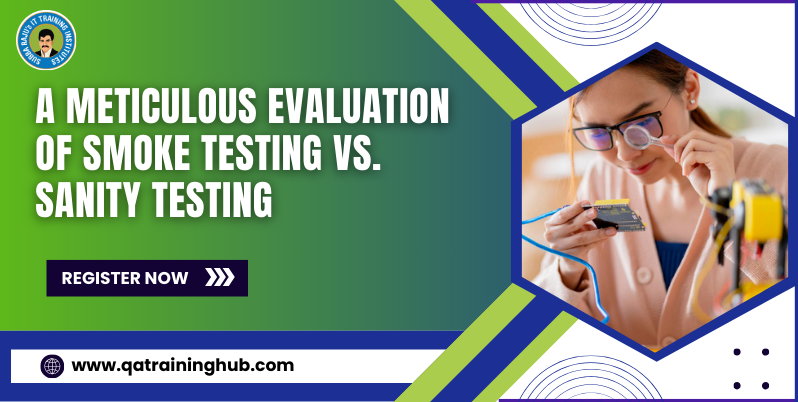
Software testing has become an essential field, ensuring that applications and systems operate smoothly, securely, and effectively. For anyone looking to enter this dynamic domain, understanding the software testing fundamentals by Subba Raju Sir is critical. With QA Training Hub’s comprehensive “Software Testing Fundamentals” course, guided by the expertise of Subba Raju Sir, you’ll acquire the essential skills and knowledge to excel in this domain.
Software testing is a crucial phase in the software development lifecycle (SDLC) that ensures a product’s quality, functionality, and reliability before it reaches the end-user. In today’s tech-driven world, software is embedded in nearly every aspect of our daily lives, from mobile apps and online banking to healthcare systems and transportation networks. Given this vast influence, even minor defects can have significant consequences, impacting user satisfaction, business operations, and sometimes even safety.
Testing is the systematic process of identifying and resolving issues or “bugs” that may disrupt the intended function of software. This process aims to validate that the software meets all specified requirements and performs seamlessly under diverse conditions. Software testing is more than just about detecting errors—it’s about enhancing software quality and building user confidence in the product.
Why Software Testing is Essential in the SDLC
Software testing is not an isolated activity; it’s an integral part of the SDLC. With thorough testing, companies can ensure that:
- Quality Standards Are Met: Testing allows developers to gauge whether the software adheres to high-quality standards, ensuring customer satisfaction and loyalty.
- Business Risks Are Minimized: Identifying and addressing bugs early in the development cycle helps reduce costs associated with post-release fixes.
- User Experience is Optimized: By catching and resolving usability issues, testing improves user satisfaction, making the software easy, efficient, and enjoyable to use.
- System Security is Enhanced: In today’s environment, with increased data sensitivity and security concerns, rigorous testing helps identify vulnerabilities that could otherwise be exploited.
By uncovering bugs and potential failures before software is released, testing helps safeguard not only the end-user experience but also a company’s reputation and bottom line.
Who Can Do This Course?
This course is ideal for:
- Aspiring Testers: People new to software testing who want to build a strong foundation.
- Software Engineers: Professionals looking to understand the testing phase of SDLC better.
- Quality Assurance Professionals: Those who want to upgrade their skills or advance in their QA career.
- Students and Fresh Graduates: Freshers who are interested in IT and want to specialize in a high-demand field.
What is Software?
Software is a set of instructions that enable a computer to perform specific tasks. These can range from simple applications like calculators to complex systems like enterprise resource planning (ERP) solutions. Software is a collection of instructions, data, or programs that enable a computer to perform specific tasks or functions. Unlike hardware, which is the physical component of a computer, software is intangible and encompasses a wide range of applications that help users accomplish tasks, solve problems, or entertain themselves. It serves as the intermediary between users and hardware, translating commands into actions that the machine can execute. Software can be classified into several types, such as system software (like operating systems that manage hardware), application software (like word processors and games), and utility software (like antivirus programs). In today’s digital world, software is essential in virtually every industry, powering everything from personal devices to complex enterprise systems and critical infrastructure.
Introduction to Software Testing
Software testing is the process of evaluating a software application to ensure it meets specified requirements and is free of bugs. It is essential to delivering quality software that performs reliably in real-world conditions. Software testing is a vital phase in the software development lifecycle (SDLC) focused on verifying and validating that software meets specified requirements and functions reliably under various conditions. It involves systematically identifying defects or “bugs” and resolving them to ensure a high-quality product. Testing goes beyond just finding errors; it’s essential for enhancing software quality, improving user experience, and reducing potential risks. By thoroughly testing applications before release, organizations can safeguard their reputation, minimize costly post-launch fixes, and deliver a product that is both reliable and user-friendly. With growing reliance on technology, effective software testing is crucial for building user trust and ensuring seamless functionality in today’s digital world.
What is Software Quality?
Software quality is the measure of how well a software product performs its intended functions, aligns with user requirements, and meets industry standards. High-quality software should be reliable, efficient, and secure, providing a seamless and positive user experience. Quality in software is not only about functionality—it also encompasses aspects like maintainability, usability, and performance. For example, well-constructed software should be easy to navigate, quick to execute tasks, and robust enough to handle various scenarios without crashing. Additionally, it should be adaptable for future changes and scalable as user needs evolve. Ensuring software quality requires careful planning, rigorous testing, and continuous improvement throughout the development lifecycle, ultimately leading to higher customer satisfaction and reduced long-term maintenance costs.
What is a Project?
A project is a temporary endeavor undertaken to create a unique product, service, or result. In software development, a project has a defined beginning and end, with specific goals and deliverables.
What is a Product?
A product is a tangible or intangible result that is delivered to users or clients after the successful completion of a project. It may be a mobile app, website, or any digital platform designed to solve a user’s needs or provide a service.
Objective and Scope of Testing
The primary objective of software testing is to verify that the software performs as expected without any issues, ensuring that all components function harmoniously. The scope of testing involves determining what needs to be tested, identifying test objectives, and defining the boundaries of the testing process.
Why is Testing Required?
Testing is necessary to:
- Detect and fix defects before the software is released.
- Ensure the software performs as intended across various conditions.
- Enhance user satisfaction and safety.
- Save costs associated with post-release fixes and potential recalls.
Error, Defect, Bug, and Failure
- Error: A human mistake in the code.
- Defect/Bug: A flaw or issue found in the software that deviates from requirements.
- Failure: When the software doesn’t deliver the expected results during execution.
Why Does Software Have Defects?
Software defects can arise due to various reasons, including:
- Human Error: Developers may make mistakes in code logic or syntax.
- Incomplete Requirements: Ambiguities or misunderstandings in requirements lead to incorrect implementations.
- Time Constraints: Tight deadlines may lead to rushed code or insufficient testing.
- Environmental Factors: Compatibility issues with various devices, operating systems, or browsers.
Quality Factors in Software
To ensure high-quality software, certain factors are crucial:
- Functionality: How well the software meets its purpose.
- Reliability: Consistent performance over time without failures.
- Usability: Ease of use for intended users.
- Efficiency: Optimal use of resources like memory, CPU, and network.
- Maintainability: Ease of modification and updates.
- Portability: Ability to run across various environments and platforms.
Conclusion
With this comprehensive course on Software Testing Fundamentals by Subba Raju Sir at QA Training Hub, you’ll gain an in-depth understanding of these core concepts in software testing. From understanding SDLC to mastering the tools and techniques of testing, this course is designed to set you up for success in the software testing industry.
Software testing is a vital component of the SDLC, ensuring that applications not only meet specified requirements but also perform reliably, efficiently, and to user satisfaction. By taking the Software Testing Fundamentals course at QA Training Hub, led by the knowledgeable Subba Raju Sir, you will gain in-depth insights into testing processes, error handling, quality factors, and industry standards that drive quality assurance.
This course offers a structured pathway for beginners and professionals alike, equipping them with the skills to identify, report, and resolve defects effectively. As software continues to power industries worldwide, the demand for skilled testers only grows. By mastering these fundamentals, you’re not just building a career in testing but contributing to a critical aspect of the software development lifecycle—delivering quality products that users can trust.
Whether you’re aiming to start fresh in software testing or enhance your existing skills, this course offers a strong foundation. With the expertise of Subba Raju Sir guiding you through each concept, you’ll emerge with the knowledge and confidence to tackle real-world testing challenges and excel in your role.







